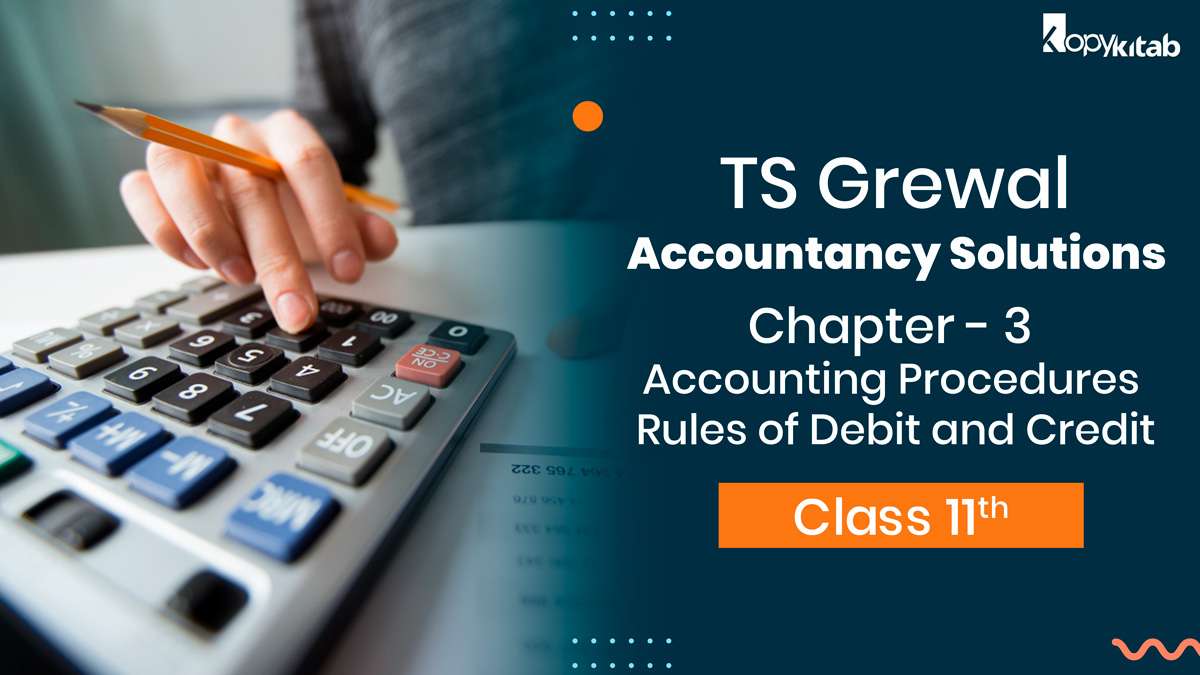
TS Grewal Class 11 Accountancy Solutions Chapter 3 – Accounting Procedures: Rules of Debit and Credit, is a useful guide in the field of Accountancy and will enhance its knowledge too.
All the important points are mentioned in the TS Grewal Class 11 Accountancy Solution, so it will be beneficial from an exam point of view. This article covers the topics from Chapter 3.
- Read More: TS Grewal Class 11 Solutions
Download TS Grewal Class 11 Accountancy Solutions Chapter 3 – Accounting Procedures PDF
TS Grewal Class 11 Accountancy Solutions Chapter 3 – Accounting Procedures
Detailed TS Grewal Class 11 Accountancy Solutions Chapter 3 – Accounting Procedures
At the beginning of Chapter 3, TS Grewal Class 11 Accountancy Solutions is teaching the students about the fundamental steps in the accounting process. The topic, “Recording the transactions – Journal and Ledger” is important from an exam point of view. Journal and Ledger keep the track of all the debits and credits in a transaction.
The concept of a Double Accounting System is explained in the TS Grewal Class 11 Accountancy Solutions. It explained the Double Accounting System is explained as a track of two aspects of each transaction, which is explained with details and precision, thanks to TS Grewal. All the rules of credit and debt and how are they applied for both capital and liability is also explained.
Students will find a detailed explanation of entries of credit and debit for decreasing expenses, increasing revenue, recording all the drawings, as well as the fresh capital introduced by the owner.
The concept of Analysis using the entries of debit and credit might be a little tricky for some students to comprehend, but TS Grewal Class 11 Accountancy Solutions has framed the concept in such a way that is easy for them to understand. Apart from that, TS Grewal has made sure to explain to the students about Journal and Ledger by using different examples of customers.
Students will also find a detailed explanation of the concept, sources, and vouchers, in the TS Grewal Class 11 Accountancy Solutions.
Class 11 Accountancy TS Grewal Sample Questions
Sample question 1:
Classify the following terms, mentioned below, into liabilities, revenues, assets, capital, and expenses:
- Outstanding expenses
- Capital
- Goodwill
- Accrued income
- Advanced income
- Furniture and fixtures
- Carriage outwards
- Carriage inwards
- Discount received
- Bills payable
- Wages
- Purchases
- Plant and machinery
- Sales
- Bank loan
- Rent
Answer:
|
Liabilities |
Revenues |
Assets |
Capital |
Expenses |
|
Bank loan |
Discount received |
Plant and machinery |
Capital |
Carriage outwards |
|
Bills payable |
Bank loan |
Goodwill |
|
Carriage inwards |
|
Outstanding expenses |
|
Accrued income |
Wages |
|
|
Advanced income |
|
Furniture and fixtures |
Purchases |
|
|
|
|
|
|
Rent |
Sample question 2:
Classify the following terms, mentioned below, into nominal, personal, and real accounts:
- Bad debts
- Freight
- Drawings
- Goodwill
- Land
- Building
- Creditors
Answer:
|
Nominal |
Personal |
Real |
|
Freight |
Drawings |
Goodwill |
|
Bad debts |
Creditors |
Land |
|
|
|
Building |
Determine the side where an increase in the following accounts will be recorded, as well as mention the nature of the account.
- Furniture A/C
- Mohan (Proprietor)
- Salary A/C
- Purchases A/C
- Sales A/C
- Interest paid A/C
- Sohan (Creditor)
- Ram (Debtor)
Answer:
|
Name of the Accounts |
Consequence of increase |
Modern approach |
Traditional approach |
|
Furniture A/C |
Debit |
Assets |
Real Account |
|
Mohan (Proprietor) |
Credit |
Capital |
Personal Account |
|
Expense |
Debit |
Expense |
Nominal Account |
|
Purchases A/C |
Debit |
Expense |
Nominal Account |
|
Sales A/C |
Credit |
Revenue |
Nominal Account |
|
Interest paid A/C |
Debit |
Expense |
Nominal Account |
|
Sohan (Creditor) |
Credit |
Liabilities |
Personal Account |
|
Ram (Debtor) |
Debit |
Assets |
Personal Account |
For further queries regarding the CBSE TS Grewal Class 11 Accountancy Solutions Chapter 3 – Accounting Procedures – Rules of Debit and Credit, you can ask in the comment section.
FAQs – TS Grewal Class 11 Accountancy Solutions Chapter 3 – Accounting Procedures – Rules of Debit and Credit
How do you define debit?
A debit (DR) is defined as an accounting entry, resulting in either an increase in assets or a decrease in liabilities.
How do you define credit?
Credit (CR) is defined as an accounting entry, resulting in either an increase in the liabilities and equity or a decrease in the assets, on a company’s balance sheet.
Define a voucher.
A voucher is defined as a written document providing proof of a business transaction. It is a source document used as proof for recording transactions in the primary books of business, i.e., a Journal or any other Subsidiary book. It is of 2 types: Accounting voucher and Source voucher.
